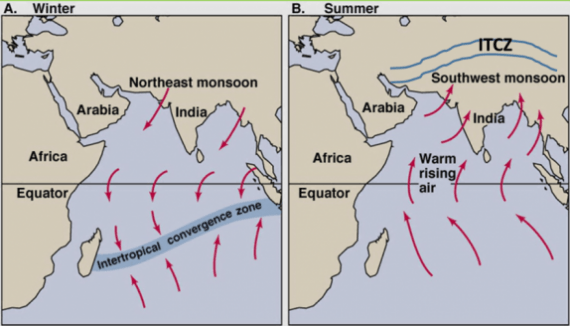In this section, we will study atmospheric humidity, types of rainfall, and distribution of rainfall.
Atmospheric Humidity
The moisture content of air measured as the proposition of water vapor mixed in the air is called Atmospheric Humidity. Atmospheric humidity depends on two sources of influence namely, the first temperature of Air and the second is a source of moisture (Water bodies, forestand Onshore winds). Atmospheric humidity is measured by Hygrometer.
The temperature of Air: as temperature increases, it influences the following changes:
- It increases the rate of evapotranspiration.
- It increases the moisture-holding capacity of air.
To indicate atmospheric humidity relative humidity is used which is given by:
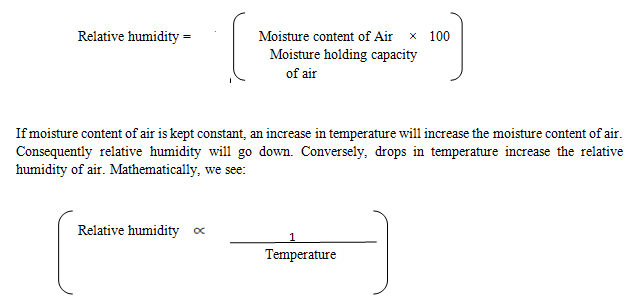
This is why we see that relative humidity is at its maximum in the early morning and decreases with the passage of the day as sunshine increases the Temperature.

Atmospheric Humidity at the various geographic location
At the Equator
- Air is hotter.
- Sources of Moisture is also high due to the presence of rain forests high rate of transpiration.
- Because both sources of moisture &temp in high, relative humidity is highest.
At the Tropics
- The pressure of tropical deserts makes sources are sent.
- Winds are offshore & the presence of barren land results in no source of evapotranspiration & humidity.
- Air is hot (holding capacity is high) but relative humidity is the Lowest.
At Poles
- Air is cold & dry (low temperature).
- There is no vegetation No source of evapotranspiration.
- Coved with ice. Hence no evaporation also.
- The relative humidity is high but not as high as that in the equation
The potential Rainfall of a given region is directly proportional to the moisture content of the air. Since the moisture content of air is high in the equatorial regions, its potential rainfall is high and at the poles since the moisture content of air is low, its potential rainfall is low.
For constant temperature, we have dry air to be denser than moist air for a constant volume because the rise of hot and humid air is therefore determined by its temperature and vapor content.
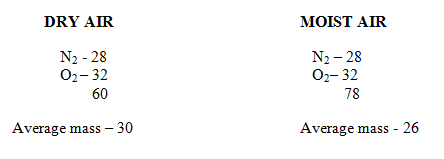
Cloud Formation & Rainfall

The rise of hot & humid air is a prerequisite for the formation of clouds. The rise of hot & humid air is accompanied by cooling with increasing altitude. This cooling of hot & humid air results in its Condensation. Here water vapors change to a mixture of water liquid phase droplets and ice solid-phase crystals which we call Clouds.
More the water vapor, the thicker the clouds. Thicker the clouds over a place more are the rainfall over it. Rainfall is not produced by all clouds. It is produced only if the weight of the cloud (weight thickness) is greater than upthrust pushing it upwards.
Types of Rainfall
Factors responsible for the rise of hot and humid air result in different types of rainfall as under.
Convectional Rainfall
Convection is the vertical rise of hot and light air for convectional rainfall there should be a source of moisture. Moisture is provided by water bodies and forest cover whereas the second requirement for convectional rainfall is temperature is being provided by high sunshine and high surface temperature.
In the equatorial region, all these conditions are met with maximum monthly temperature in April & October. Hence, the maxima of monthly rainfall also coincide
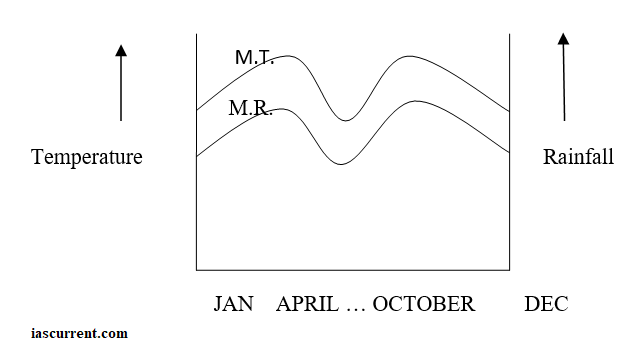
This kind of rainfall is seen in sub-tropical regions during the onset of summer; hence these are called pre-monsoon showers with local names. Pre-monsoon showers reduce the temperature to below 40°c producing temporary cooling.

Orographic Rainfall
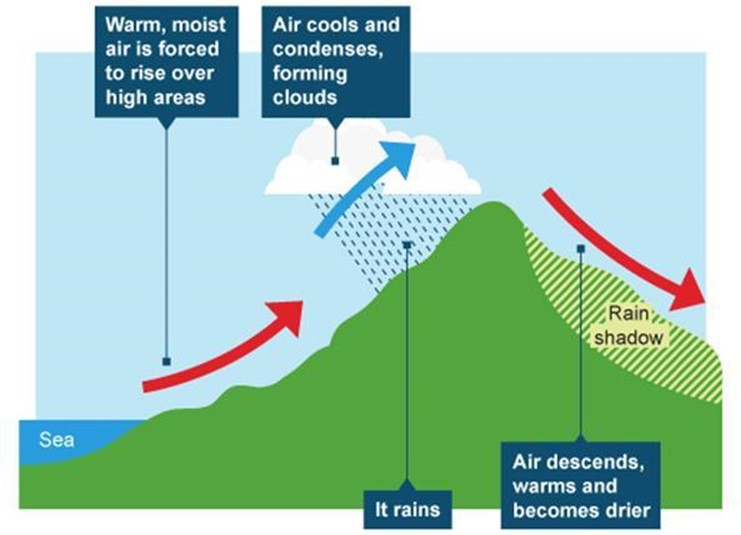
There are certain pre-conditions required for this type of rainfall which is as follows:
- There must be Hot & Humid onshore wind.
- Presence of a hill or mountain across the onshore wind. The amount of rainfall on the windward side of the mountain depends on proximity to the sea/ocean, the altitude of the hill/mountain, and the slope of the hill/mountain.
The orographic effect produces the greatest amount of rainfall in the world its source i.e. on winds is from oceans which cover 71 of the earth’s surface. Therefore, Orographic rainfall dominates global rainfall.
Frontal Rainfall
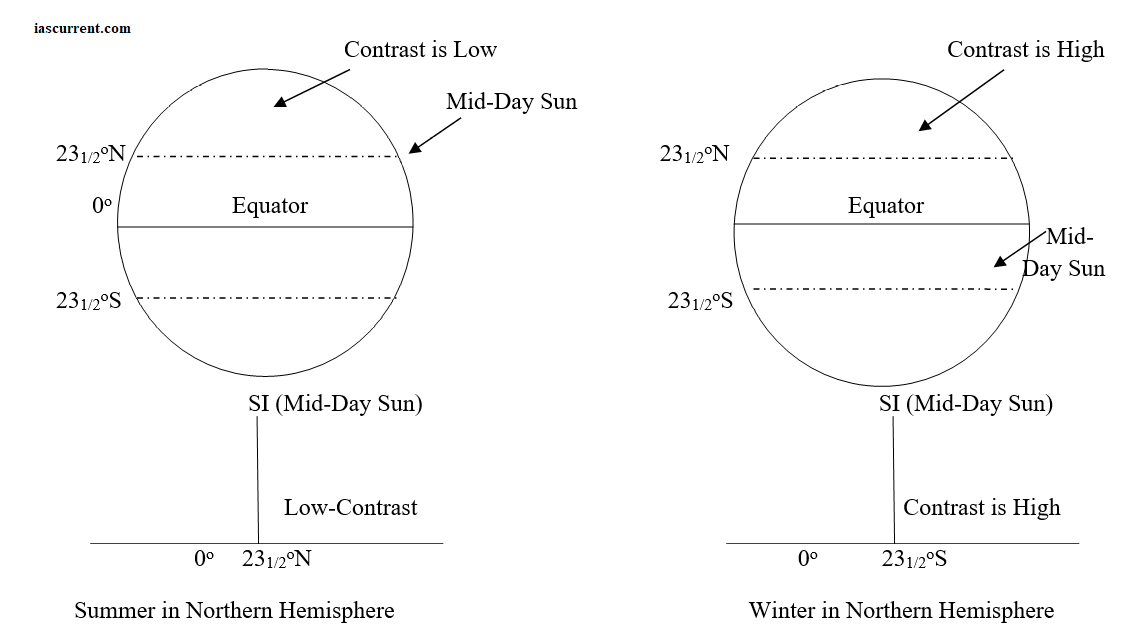
A precondition for frontal rainfall is the convergence of contrasting winds. This contrast is dominant in the winter season. So the frontal rainfall is most intense and frequent in the mid-latitudes
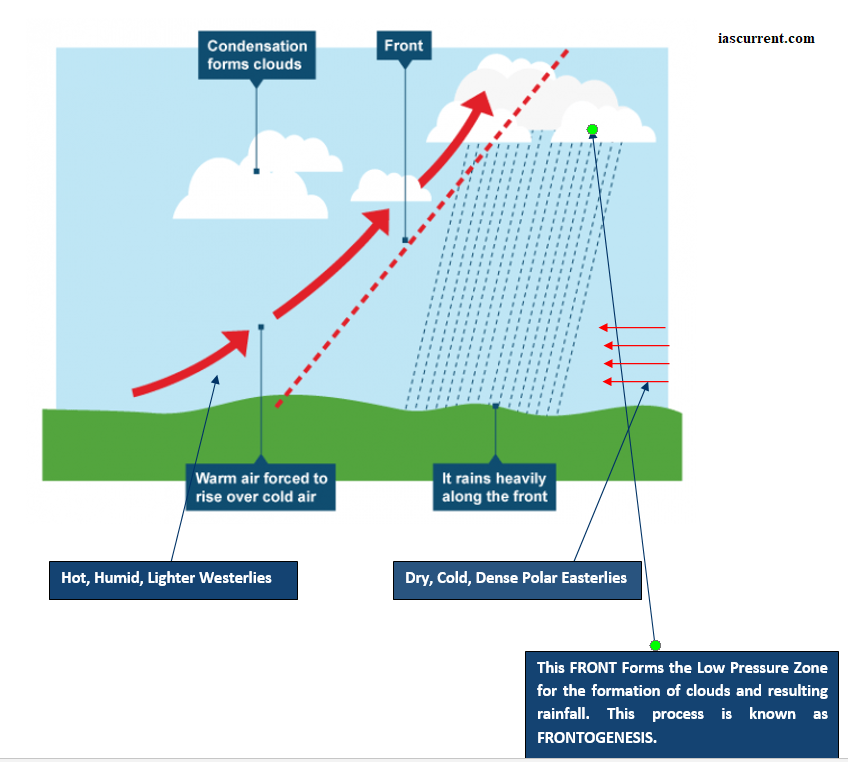
Since these originate in the mid-latitudes, they are called temperate cyclones. Due to low pressure, both the air masses will circulate and with the help of Coriolis force, the cyclone will form and produce rainfall. This rainfall is most common in mid-latitudes. In India, this rainfall is common in the North-Western part during the winter season. This rainfall is called Western Disturbances. Avalanche is the downward flow of snow under the influence of gravity, this is common during the winter season.
Distribution of Rainfall
The distribution of rainfall originates from many factors such as:
- Distribution from Coast: Places near the coast receive high rainfall and places far away from the coast receive low rainfall.
- The direction of Wind: Places under the influence of “onshore” wind receive high rainfall and places far away receive extremely low rainfall.
- Orographic Effect

4. Cyclones and Anti – Cyclones: The Geographical areas under the influence of cyclone produces high rainfall the formation. Anti-cyclones produce cloudless, rainless conditions.

Highest Rainfall Regions
- Equatorial Regions – Rainfall is throughout the influence of Doldrums.
- West- the coast of continents in the mid-latitudes – westerlies are onshore throughout the year. They are never offshore.
- North East or South West Monsoon winds with orographic effect with the orographic effect, North East & South West Monsoon wind produce high rainfall.
Lowest Rainfall Region
- Trade winds are offshore throughout the year in the subtropical region on the west coast of continents
- In mid-latitudes deep wide continents deep inside continents and leeward ride of mountains e.g.: Tibet & Ladakh.
- Polar Region: Since the temperature is low, the moisture-holding capacity is low. So rainfall will also below.

